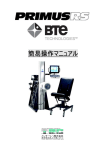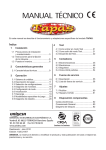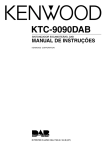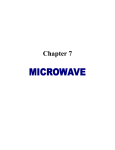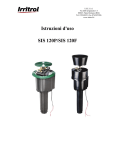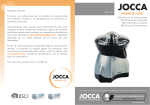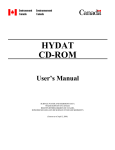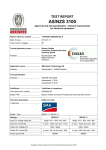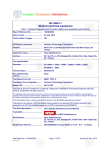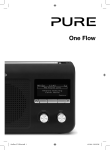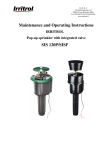Download Hickock 539C User`s Manual
Transcript
TRANSCONDUCTANCE TUBE TESTER MODEL 539C © THE HICKOK ELECTRICAL INSTRUMENT CO.—1968 10514 DUPONT PNONE—541-8060 TWX—CV 662 AVENUE • CLEVELAND, OHIO 44108 CABLE—HICKOK, CLEVELAND WESTERN UNION—KJ WARRANTY The Hickok Electrical Instrument Company warrants instruments of its manufacture to be free from defects in material and workmanship for ninety (90) days from the date of original purchase. Any instrument found to be defective during this period may be returned, transportation prepaid, to the factory for repair, or at our option, replaced without charge. This warranty does not apply to any of our products which have been repaired or altered by unauthorized persons, or which have been subject to misuse, negligence, or accident, or which have had the serial number altered, effaced or removed. Neither shall the warranty apply where a warranty registration card has not been properly completed and returned to us promptly after purchase. This warranty is in lieu of all other warranties whether expressed or implied. RETURNING EQUIPMENT FOR REPAIR Before returning any equipment for service, the factory must first be contacted, giving the nature of the trouble. Instructions will then be given for either correcting the trouble or returning the equipment. Upon authorization, this equipment should be forwarded directly either to the Hickok factory address at 10514 Dupont Avenue, Cleveland, Ohio, 44108, or to a designated service station in your locality. 19120-153 OPERATING INSTRUCTIONS FOR MODEL 539C TRANSCONDUCTANCE TUBE TESTER FOREWORD The Model 539C Mutual Conductance (Transconductance) Tube Tester is designed for use by technicians, engineers and others who demand an instrument of the very highest quality for rapid and accurate testing of vacuum tubes. Like all Hickok Tube Testers, it is based upon the well known formula for mutual conductance, ∆ip = Gm ∆eg where ip is the plate current change, eg is the grid voltage change, and Gm is the Mutual Conductance (Transconductance). Mutual Conductance and Transconductance are used interchangeably. This instrument is equipped with three meters, all made in our own plant, and calibrated with great accuracy. (a) A sensitive Transconductance meter measuring micromhos in six ranges up to 60,000 micromhos. This meter also has a scale reading to 200 volts for V. R. tube testing, and a scale reading to 50 megohms for leakage testing. (b) An A.C. voltmeter which insures standardized voltages to the tube's base, and (c) A two range (0-10, 0-50) D.C. voltmeter to accurately adjust the negative bias on the tube's control grid. Also a scale to 100 M. A. d. c. for V. R. milliamperes. Voltage adjustments are made while the tube being tested is delivering its rated load. NOTE: Always check a tube for shorts before proceeding with Mutual Conductance test. OPERATING INSTRUCTIONS Read these instructions through before attempting to operate the tester. 1. There are two rectifier tubes, an 83 and a 5Y3GT necessary to operate this tester. They are included. The Short Lamp is a 1/ 25 watt, 110 volt, miniature bayonet base neon signal lamp. This lamp will last indefinitely unless broken. The Fuse Lamp is a standard No. 81, single contact auto bulb. This can be procured from any auto dealer or gasoline station attendant. This fuse lamp is in the primary circuit of the transformer. -1- FUNCTIONS OF THE VARIOUS CONTROLS 3. The line adjustment control rheostat in the 539C Tester is connected with a small A.C. voltmeter as a constant calibration indicator which is normally always in circuit. The small A.C. voltmeter may also be used to register 60 cycles A.C. line voltage fed to the set by operating the test button P7 designated "LINE TEST" in the lower right part of the control panel. Readjust after pressing the P4 Test Button. 4. Selectors: The row of seven selector switches across the center of the control panel is for the purpose of conducting proper voltages to the tube's base pins. On the roll data chart, below the word "Selectors" appear the switch settings. Example: JR-6237-5. Starting at the left the first switch is set at "J", the second switch at "R", the third at "6", the fourth "2", the fifth "3", the sixth "7" and the seventh "5". The first two switches control the filament or heater connections. The other switches control the GRID, PLATE, SCREEN, CATHODE and SUPPRESSOR in that order. In the example given above, the heater terminals are connected to pins 8 and 1. The GRID is connected to pin 6; PLATE, to pin 2; SCREEN, to pin 3; CATHODE, to pin 7 and SUPPRESSOR, to pin 5. These switches are electrically interlocked in such a way that it is impossible to connect two different voltage elements to the same pin. Thus accidental shorts are avoided. 5. Short Test In the Model 539C, Hickok has introduced an entirely new concept in short and leakage testing. In addition to the conventional neon lamp short indication, there is a d.c. leakage test which registers up to 50 megohms on the scale of the large Gm meter. Neon Lamp Short Teat. Turning the SHORTS switch successively through the positions 1-2-3-4-5 connects the various pairs of elements in turn across the test voltage. Tubes having shorted elements will complete the circuit and cause the neon SHORT lamp to glow. Tubes may be tested for shorts, either hot or cold. Normal sensitivity of the neon lamp is about 1/3 Megohm. A short is indicated by a steady glow of the neon lamp in certain positions of the SHORTS switch. A shorted tube should be discarded without further test. An improved neon Short Test is incorporated in the design of this tube tester. Wide experience has demonstrated that most satisfactory results are obtained when tubes are classified for short test purposes. The toggle switch is thrown to miniature and subminiature position for all subminiature, button seven pin and button nine pin tubes. The other position is used for rubes having regular base pins, including loktal base tubes. 6. Locating Shorted Elements by Neon Lamp. In the following table (X) under any position indicates that the neon lamp glows in that position. -2- KIND OF SHORT 1 2 3 4 HEATER - CATHODE X HEATER - GRID X X HEATER - SCREEN X X X HEATER - PLATE X X X X HEATER - SUPPRESSOR X X X X CATHODE - GRID X CATHODE - SCREEN X X CATH0DE - PLATE X X X CATHODE - SUPPRESSOR X X X GRID - SCREEN X GRID - PLATE X X GRID - SUPPRESSOR X X SCREEN - PLATE X SCREEN - SUPPRESSOR X PLATE - SUPPRESSOR 5 X X X X X 6a. Heater Cathode Leakage: A particularly troublesome defect in tubes, especially those used in television, is a leakage between heater and cathode. This leakage may be quite high, sometimes running to several megohms. It may be too high to cause the neon lamp to glow in the ordinary way. However, these leaks may be detected on your new 539C. You will note that a heater-cathode short will cause the neon lamp to glow on position 1 (one). While the short switch is resting on position 1 (one), during short test operation a condenser will be charging through the leak. If the switch is turned from position 1 (one) to position 2 (two), a sharp flash of the neon lamp will be seen. This will not repeat until the switch is again turned to position 1 (one) allowing the condenser to recharge through the leakage. Many baffling cases of trouble can be located in this way. It has been established that heater cathode leakage as high as 30 megohms will cause "noise" in repeater circuits in television service on coaxial lines. 6b. Noise Test: The short test circuit is also used in making noise tests on vacuum tubes. Connections are made from the noise test jacks to the antenna and ground posts of any radio receiver. The tube under test is tapped with the finger as the SHORTS switch is turned through positions 1-2-3-4-5. 7. Intermittent disturbances which are too brief to register on the neon lamp will be reproduced by the loud speaker as static. Leakage Test on Meter: An added feature in the Model 539C is its ability to measure element leakage up to 50 megohms on the dial of the large Gm meter. The research -3- engineer and technician will find this feature a great aid in routine investigations. Every engineer knows that in certain tube applications, leakage is more significant than in others. The metered leakage feature of the Model 5390 will enable him to form sound judgment as to the leakage to be tolerated in different applications. 7a. Operating Leakage Test: Turning the SHORTS switch through positions A, B, C, D, E isolates tube elements successively from all other elements and registers the leakage in megohms between the chosen element and all others connected in parallel. Forty volts d. c. is applied in this test. The significance of the lettered positions of the short switch is as follows: *A - HEATER isolated from other elements. B - GRID isolated from other elements. C - SCREEN isolated from other elements. D - PLATE isolated from other elements. E - SUPPRESSOR isolated from other elements. *NOTE: Position A includes heater-cathode leakage. In tubes having filamentary cathodes, the heater and cathode are identical; therefore the meter will normally indicate near the zero mark on position A of the shorts switch. 8. Gas Test: The push switches P5 (Gas 1) and P6 (Gas 2) are used to test amplifier tubes for gas content. a. Make Micromho test in the ordinary way. b. Set the Bias Voltmeter switch to the 50 volt range and the Function switch to posi-tion D. Hold down P5 and adjust the Bias control to bring the meter reading down to 500 on the 3000 scale. c. Hold down P5 and press P6. Because of a charging capacitor the meter will de-flect either up scale or down scale about one division, after P6 is pressed, and will settle to a new reading. An upscale reading after settling is the result of grid current due to gas or grid emission (sometimes referred to as poisoned grid). If the upward movement is not more than one large division (two small divisions), the gas content is satisfactory. Some tubes develop gas after being heater for a period of time. If a tube is sus-pected, allow it to heat for a few minutes. This constitutes a very sensitive gas test. Gas content on the order of 0. 1 microampere can be detected. Gas content is a very important factor in modern receivers of all types, con-taining AVC and AFC circuits as the presence of gas causes the grid to become conductive and as changes in grid bias operate through resistors of comparatively high value, correct functioning cannot be obtained with a gassy tube. The presence of gas results in actually changing the grid bias. Gas is especially harmful in television rubes. 9. Dynamic Transconductance: The Push Switch P4 is mechanically divided into two sections, non-locking and locking. Both sections perform identical electrical functions. If momentary contact is needed, press the non-locking button. If extensive tests are to be made, use the locking button. The locking button is released by pressing the non-locking button. -4- The indicating meter will register the tube's value in eight ranges: A. B. C. D. E. F. G. H. 60,000 µmho at .25 Volt signal. 30,000 µmho at .25 Volt signal. 15,000 µmho at .25 Volt signal. 6,000 µmho at .5 Volt signal. 3,000 µmho at 2.5 Volt signal. 600 µmho at 1. Volt signal. Rectifiers and Diodes, no signal. Voltage Regulator tubes. The 600 micromho range was designed especially to test subminiature tubes. Low plate and screen volts are automatically applied when FUNCTION switch is set on position F. The FUNCTION switch automatically changes the signal volts when the appropriate setting is made. The chart setting for the tube to be tested will indicate where the FUNCTION switch should be set, such as A, B, C, D, E, F, G or H, in the column preceding Micromhos. The Micromho values printed on the data roll are minimum values. Good tubes will read above these values. In the column headed BIAS VOLTS is listed the exact voltage to which the BIAS VOLTS meter is to be set when testing a tube. Make final bias adjustment after the P4 button is pressed. Certain pentode tubes, such as the 3A4, are tested with reduced screen voltage. This is accomplished by holding down P1 and pressing P4. Specific instructions are printed in the NOTATIONS column for each tube requiring reduced screen voltage. 10. Rectifier Test. The push switches P1, P2 and P3 are used to test various types of rectifier elements. a. The push switch PI is used when testing detector diodes. It applies a low voltage which will not injure the delicate cathode. Good diodes will cause the meter pointer to read above mark, RECTIFIERS and DIODES O.K. b. Push switch P2 is used when testing cold cathode rectifiers such as the OZ4. This applies a voltage sufficiently high to ionize the tube and start conduction. Good tubes will read above the mark, RECTIFIERS and DIODES O.K. c. Push switch P3 is used when testing ordinary rectifier tubes such as the 5Y3. This switch applies a medium voltage which is best adapted to reveal defects in this type of tube. Good tubes will read above the mark, RECTIFIERS and DIODES O.K. In the chart column headed SHUNT are listed the numbers to which the SHUNT dial is to be set when testing Rectifiers and Diodes. -5- 11. Socket Numbering. Sockets are wired according to EIA numbering, and the numerical values of the lettered dials are as follows: Selector Positions Socket Connections A .... P .... 0 B .... R .... 1 C .... S .... 2 D .... T .... 3 E .... U .... 4 F .... V .... 5 G .... W.... 6 H .... X .... 7 J .... Y .... 8 K .... Z .... 9 1 .... 1 .... W 2 .... 2 .... X 3 .... 3 .... Y 4 .... 4 .... Z No Connection 1 2 3 4 5 6 7 8 9 10 11 12 No Connection 12. Meter Reverse. Directly below the indicating meter is a switch marked REVERSE-NORMAL. With certain tubes such as the 117N7, the meter, when set on NORMAL, will deflect backwards (to the left) when push switch P3 is pressed for rectifier test. In such case turn the meter switch to REVERSE which will cause the pointer to move up the scale. After this test has been made, return the switch to NORMAL. 13. Top Caps. There are two jacks in the upper center of the control panel marked GRID and PLATE. These are used when making connection to the top cap of the tube being tested. On the data chart in the NOTATIONS column opposite tube types having top caps, is the notation CAP = G, or CAP = P. G means that the top cap is connected to the GRID and P, to the PLATE jack. 14. Special Notes. Power line voltage varies with different localities. It may also vary with the different hours of the day. While a national survey indicates that the average voltage for the USA is 117 volts, it does not mean that every locality maintains a constant voltage at that level. Occasionally we have had the complaint that a used tube will test GOOD, but will not work in the radio receiver; but when a NEW tube is substituted, the receiver will operate correctly. The answer is this: Tubes are built to specifications. Our tube testers are designed to test tubes in conformity with these specifications. The used tube that would not perform in a certain receiver was not receiving its specified filament voltage. The new tube performed because of its initial reserve capacity. The used tube would have performed if it had received its specified filament voltage. Tube failure frequently occurs in A. C. - D. C. sets where several tubes are connected with their heaters or filaments in series. Sometimes, even though the power line voltage is normal, a series tube with abnormally high filament resistance will rob its companion tube of its normal filament voltage. The robbed tube apparently fails; but when tested under specified conditions, the tube will test GOOD. -6- The Model 539C is valuable in matching tubes for push-pull stages and other appli-cations where matched tubes are essential. 15. Life Test. The Model 539C DYNAMIC MUTUAL CONDUCTANCE TUBE TES-TER is equipped with a special feature to enable Life Test to be made on the tube. In the center of the control panel is a switch designated CATH. ACT., NORM, and TEST. While holding everything else at normal this switch reduces the filament voltage by 10%. a. Measure the mutual conductance in the ordinary way with switch set on NOR-MAL. b. Throw the CATH. ACT. switch to TEST position. The mutual conductance should not drop more than 20%. c. After making life test return the switch to NORMAL for all other tests. In testing the 35Z5 and 45Z5 rectifier tubes it is advisable to turn the power off for about 15 seconds after throwing the CATH. ACT. switch to TEST to allow the cathode to cool. Then turn the power on and note new reading of the meter. 16. Self Bias. Provision is made to test tubes under self bias condition. In the up-per edge of the control panel are two binding posts designated SELF BIAS. These posts are normally shorted by an attached bar. To use SELF BIAS, connect a suitable bias re-sistor together with an electrolytic capacitor of 2000 Ofd in parallel across these binding posts. The positive terminal of the capacitor should be connected to the positive binding post. The toggle switch in the upper left of the control panel is thrown from NORMAL po-sition to the SELF BIAS position. The bias volts under self bias condition depends upon the value of the resistor inserted between the self bias posts mentioned above, and also upon the plate current flowing. Tube handbooks can be used as a guide to the value of the self bias resistance to use. When completing the self bias test, reconnect the two binding posts by the normal short-ing bar and throw the toggle switch back to the NORMAL position. 17. Plate Current. In the upper center of the control panel are two posts designated PLATE CURRENT. These posts are normally shorted by an attached bar. A suitable low resistance D. C. milliammeter connected across these posts will measure the plate current flowing through the tube being tested. Connect the positive terminal of the meter to the positive binding post. NOTE A D. C. milliammeter connected into the SELF BIAS circuit will measure the total cathode current. In measuring rectifier tube current the meter reading must be multiplied by two, because rectifier tubes conduct only during a positive half-cycle, whereas the meter integrates over a complete cycle. In checking thyratrons such as the 884 and 885, the bias voltmeter should be set initially at its highest negative value (about 40 volts). The designated button is held down while the bias voltage is gradually reduced until the tube "strikes", that is, begins to conduct, which is indicated by a sudden deflection of the meter. The chart indicates the approximate voltage at which the tube strikes. There may be a small variation above or be-7- low the given striking voltage. The meter indication for a good tube is above the point designated “RECTIFIERS OK”. 18. Filament and Heater Continuity. 1. Turn the tester on. 2. Set the selectors as per chart for the tube to be tested. 3. Set the FILAMENT switch on BLST instead of voltage indicated on the chart. 4. Set the SHORT TEST switch on position 5. 5. Place the tube in the proper socket. If the neon lamp glows, the filament is good and a complete test should then be made on the tube, by setting FILAMENT switch on the proper tap, and while the tube heats, rotate the SHORT TEST SWITCH several times thru 1 to 5 positions. If no shorts are indicated, set the switch in TUBE TEST position and proceed to test the tube as per chart. If the neon lamp does not glow, the filament is open and further test is unnecessary. Certain tubes such as the 35Z5-50Z7, etc. , with tapped filaments have special continuity test settings; see roll chart. NOTE It sometimes happens that a filament will show continuity when cold, but will open when it warms up. 19. Voltage Regulator Tubes. a. Set the selectors for V. R. tube to be tested. The test data for V.R, tubes will be found at the top end of the roll chart. For example, the 0A3. b. Set FIL VOLTAGE switch to OFF. c. Set selector switches to AP-0502-0. d. Set function switch on range H, V.R. TEST. e. Turn the bias volts toggle switch to V.R. volts and mils. f. Turn V.R. volts knob fully counter clockwise. g. Turn power adjust knob fully clockwise. Press P4-LOCK. h. Place V.R. tube in proper socket and turn power ON. i. Turn V.R. voltage control knob slowly clockwise. The large Gm meter should start to read d.c. volts on the 0-200 volt scale. j. Example: In the notations column for the 0A3 tube appears, “Starts at about 100 Volts Regulation = 5 volts from 5 to 40 ma.”. In the column marked MIN. MUT. COND. is the nominal operating voltage for this tube - 75V. k. When the V.R. tube strikes as explained in (j) above, the voltmeter reading will drop back to operating voltage, The V. R. current is read on the 0-100 m. a. range of the bias meter. -8- 20. l. For the 0A3 example adjust the m.a. current from 5 to 40 milliamperes by turning the V.R. volts and mils knob. The 0A3 tube should not exhibit a voltage change of more than 5 volts. m. When completing a V.R. tube test unlock P4 push button. Ohmmeter Feature. The Model 539C tube tester can be used as a utility ohmmeter as follows: a. Set the SHORTS switch on position B. b. Connect two prod leads into the grid and plate jacks in the center of the control panel. The red plate jack will be the positive lead. c. Touch together the two prods and adjust the ohmmeter pointer to zero. Resistance up to 50 megohms can be read directly on the megohm range. d. Electrolytic capacitors can be checked for leakage. Observe that the red (plate) jack is connected to the positive pole of the capacitor. 21. NORMAL-LOW Plate Volts. In the NOTATIONS column of the data chart for some tubes will be found PLATE VOLTS = LOW. This notation indicates that the PLATE VOLTS switch located just above the FUNCTION switch is to be set on the LOW position. Return the switch to NORMAL for all other tubes. 22. Heater - Current. In the lower right hand corner of the panel will be found two binding posts which are normally connected together by a jumper. By removing this jumper and connecting a suitable Milliammeter or Ammeter between these two binding posts, the indicating instrument will read the current being drawn by the heaters of the tube under test. The actual voltage at the tube under test will be the voltage as indicated by the filament selector switch minus the voltage drop across the indicating Milliammeter or Ammeter. This voltage will generally be of a very low magnitude, but can be calculated by multiplying the current normally drawn by the tube under test by the impedance of the meter connected in series with this tube, or it can be actually measured with a sensitive AC Voltmeter. If the impedance of the meter is much more than 0.2 ohms, the voltage drop might be appreciable percentage-wise to the voltage delivered to the tube. For example, if the current at the tube is normally 0.6 amperes, and the impedance of the current measuring instrument were 0.5 ohms, the resultant loss would be the product of these two, or 0.3 of one volt. 23. Pilot Lamp Testing. The center of the large 7-pin socket is used to check pilot lamps. Set the filament selector switches on HR. Set the filament voltage switch to the proper voltage for the lamp being tested. -9- TO TEST BALLAST TUBES 1. 2. 3. 4. 5. Turn Tester on. Set filament switch to BLST. Set SHORT TEST switch on 5. Set first selector switch to letter shown in column marked (first selector switch). Set all numbered selectors on zero. ROTATE second selector switch. NEON LAMP SHOULD LIGHT IN POSITIONS NOTED. TUBE TYPE First Selector Neon Lamp Should Light in these positions 1A1-1B1-1C1-1E1-1F1-1G1-1J1-1K1-1V1 1Y1-1Z1 1L1-1N1-1P1-1Q1-1R1G-1S1G-1T1G-1U1G H 2 E 2UR224 H 2LR212 I R 3 E R 03G H 4-5 E 6-133 H 6-6AA-7-8-9 E 10A-10AG H 10AB E K17B-M17C-BM17C H M17HG-M17H H D E R S R T S U T R T R T R T Y R Y S K23B-K23C H KX23B E R T KX30C E R T M30H H D R T Y Y S 30A-K30A H K30D H 33A-33AG H T K34B H T 36A H T K36B-BK36B-L36B-L36C H T KX36Z E R KX36C E R 36D-L36D H L36DJ H R K36H-M36H-M36HG H D R T S T Y Y Y T S T S T Y U Y Y S 40A1 H S L40S1-L40S2 H S 42A H -10- Y T T V TUBE TYPE 42A1 42A2-42B2 K42B-L42B-M42B KX42B-LX42B-L42BX K42C-L42C-M42C BK42D-K42D-L42D LX42D-L42DX K42E-L42E L42F First Selector J J H E H H E H H D 42HA-42HJ M42H-M42HG KX42C L42SI 49A-49AJ-K49AJ KX49A 49A1 49A2-49B2 K49B-L498-M49B-BM49B-K49C M49C-BM49C-BK49C-K49E-L49E K49D-BK49D-L49D L49F R R R H E R H D E H H E J J H R H D KZ49B-KZ49C K49BJ-L49BJ L49S2 49AJ-K49AJ KX49B-LX49B-LX49C L49DJ L49S3 50A2 50A2MG-50B2 50X3 K52H-M52H H H H H E H H E H E H D K54B 55A-K55A 55A1 KX55A 55B-K55B-M55B-BM55B-L55BG LX55B 55A2-55B2 K55C-L55C H H J E H E J H -11- Y Y Y Y Y S S T Y S R S R T T T T V U U R H H D M49H-M49HG S S Neon Lamp Should Light in these positions U U T T T T T T S T Y T Y Y S R Y S S S R S S R V T T T T T T T U Y V U Y V S V R R Y S T T Y U R R R T T Y U T Y TUBE TYPE KX55C K55CP K55D-L55D L55E-M55E L55F-M55F-BL55F K55H-M55H-M55HG L55S1-L55S2 60R30G 64, 23 67A K67B-L67B L73B-K74B-L74B KX74C 80A K79B-K80B-K80C-L80B KX80B K80F KX87B-LX87B L90B K90F-M90F-K92F-M92F 92A L92B-95K2 L99D 100R8 120R 120R8 135K1 135K1A 140L4-140L8-140R4-140R8 140R 140L44 140R44 165L4-165R4-165R8 165R 165L44-165R44 185L4-185L8-185R4-185R8 185R 185L44-185R44 200R-250R 250R8 290L4 300R4-320R4 340 808-1 First Selector E H H H H D H D H E H H H H E H H E H D E H H D H H H E E E H H E E E E E E E E E E E E E E E H -12- R S Neon Lamp Should Light in these Positions T T V T T Y Y Y Y S R Y S S R R R T T T T T T T T T T V Y Y Y Y S R T T Y Y S S R R R R R R R R R R R R R R R R R R S T T T T Y Y T T T T U Y Y U Y T T T S T T S T T T T T TUBE TYPE E14980-W43357-W45788-3613 3334-3334A 3613 8593-8598-8601 8664 3CR241 3ER248 B9M15822 B9M16067 B9M16275 B9M16534 B9M17571 First Selector H H H H H H C E G H C H J H B9M18941 17A470303 17A485459 TBR102D-TBR104D TBR103D 397021 397022 397023 397036 407100 408100 SW407300 571606 S S Y Y Y Y Y Y X S S S C E G H J E H E R C G R C G R C E H B H H D R H C E H -13- S Neon Lamp Should Light in these positions T T T T T T U T V T T T T U V V V U V W W W X Y Y Y Y Y T V R S X Y X Y X Y V W T R S W T T U U V V T V W Y R R V V V S S U S R T T V W V W Y Y PARTS LIST Reference designations have been assigned to identify all parts used in this instrument. An asterisk designates a part which should be replaced by authorized Hickok repair stations or factories. It is therefore recommended that the entire instrument be returned for repair if trouble exists with such a part. In ordering parts, refer to the current parts price list for this instrument. Prices are subject to change without notice, and the minimum billing charge is REF. DESIG. C1 C2, C3 C4 C5 C6 C7 DS1 DS2 E1 thru E3 F1 F1 J1 J2 thru J4 J5 thru J10 M1 M2 M3 P1 R1 R2 R3 R4 R5 R6 R7 R8 R9 R10 R11, R12 R13 R14 R15 R16 R17 R18 R19 R20 R21 R22 R23 R24 R25 R26 R27 R28 R29 R30 R31 R32 R33 R34 R35, R36 R37 R38 NAME AND DESCRIPTION CAPACITOR, FIXED, ELECTROLYTIC: 8 uf, 350 volts CAPACITOR, FIXED, PLASTIC COATED: .05 uf, 400 volts CAPACITOR, FIXED, ELECTROLYTIC: 100 uf, 6 volts CAPACITOR, FIXED, MICA: 470 pf, 10%, 500 volts CAPACITOR, FIXED, CERAMIC: .005 uf, -0 +100%, disc type CAPACITOR, FIXED, MICA: 2700 pf, 10%, 1000 volts LAMP:, #47, 6-8 volts, . 15 amps, miniature bayonet base, clear LAMP: NE51, neon BAR: shorting HICKOCK PART NO 3085-68 3105-175 3085-40 3095-8 3110-7 3095-268 12270-12 12270-14 2145-2 LAMP: #81, bayonet type (115 volts) LAMP: #63, G. E.. (230 volts) JACK: pin plug type, red JACK: pin plug type, black 12270-2 12270-58 10300-1 10300-2 BINDING POST: black 2360-51 METER: Line test, Model 57MR METER: Model 56R METER: Model 68 CORD AND PLUG ASSEMBLY: 3 wire RESISTOR, FIXED, FILM: 150 ohms, 1%, 2 watts RESISTOR, FIXED, COMPOSITION: 470 K ohms, 10%, 1/2 watt RESISTOR, FIXED, COMPOSITION: 47 ohms, 10%, 1/2 watt RESISTOR, FIXED: 100 ohms, 10%, 10 watts, center tapped RESISTOR, FIXED, COMPOSITION: 15 K ohms, 5%, 1 watt RESISTOR, FIXED, COMPOSITION: 1200 ohms, 10%, 1 watt RESISTOR, FIXED: 1800 ohms, 10%, 10 watts RESISTOR, VARIABLE: 50 ohms RESISTOR, FIXED, FILM: 300 ohms, 1%, 1/2 watt RESISTOR, FIXED, FILM: 100 ohms, 1%, 1/2 watt RESISTOR, FIXED, FILM: 50 ohms, 1%, 1/2 watt RHEOSTAT: 350 ohms, 15%, 25 watts RESISTOR, VARIABLE: wire wound, dual 3000 ohms and 1000 ohms, Same as R8 Same as R14 RESISTOR, FIXED, FILM: 2250 ohms, 1%, 1 watt RESISTOR, FIXED, WIRE WOUND: 8500 ohms, 10%, 10 watts RESISTOR, FIXED, FILM: 1200 ohms, 1%, 1 watt RESISTOR, FIXED, COMPOSITION: 1000 ohms, 5%, 1 watt RESISTOR, SPOOL: 560 ohms RESISTOR, FIXED, FILM: 470 K ohms, 1%, 1/2 watt RHEOSTAT: 1000 ohms, 50 watts RESISTOR, VARIABLE: 1000 ohms RESISTOR, FIXED, FILM: 150 ohms, 1%, 1/2 watt RESISTOR, FIXED, FILM: 750 ohms, 1%, 1/2 watt Same as R10 RESISTOR, FIXED, FILM: 270 ohms, 1%, 1/2 watt RESISTOR, FIXED, COMPOSITION: 10K ohms, 10%, 2 watts RESISTOR, VARIABLE: 10K ohms, 20%, 2 watts Same as R3 RESISTOR, FIXED, FILM: 230 ohms, 1%, 1/2 watt RESISTOR, FIXED, COMPOSITION: 150 K ohms, 5%, 1/2 watt RESISTOR, FIXED, COMPOSITION: 120 K Ohms, 5%, 1/2 watt RESISTOR, FIXED, FILM: 500 ohms, 1%, 1/2 watt RESISTOR, SPOOL: 60 ohms 570-450 560-812 680-302 3675-34 18540-4 18414-472 18410-472 18575-19 18423-151 18422-122 18575-12 16925-271 18537-99 18537-96 18537-65 18750-7 16925-270 -14- 18539-12 18575-89 18539-11 18422-101 18684-124 18537-66 18750-26 16925-88 18537-64 18537-98 18537-93 18433-102 16925-495 18537-97 18414-151 18414-121 18537-58 18684-113 REF. DESIG. R39,R40 R4 R42 R43 R44 R45 R46 R47 R48 R49 R50 R51 R52 R53 S1 S2 S3 S4 S5 S6 S7 S8 S9 S10 S11 thru S15 S16,S17 S18 S19 V1 V2 X1 X2 X3 X4 X5 X6 X7 X8 X9,X100 X11 X12 X13 X14 NAME AND DESCRIPTION RESISTOR, SPOOL: 40 ohms Same as R38 Same as R37 RESISTOR, SPOOL: 198 ohms RESISTOR, SPOOL: 2 ohms RESISTOR, VARIABLE: 250 K ohms RESISTOR, FIXED, COMPOSITION: 1 megohm, 10%, 1/2 watt RESISTOR, FIXED, COMPOSITION: 36 K ohms 5%, 1/2 watt RESISTOR, FIXED, FILM: 330 K ohms, 1%, 1/2 watt RESISTOR, FIXED, FILM: 40 K ohms, 1%, 1/2 watt RESISTOR, FIXED, FILM: 9900 ohms, 1%, 1/2 watt RESISTOR, FIXED, FILM: 200 ohms, 1%, 1/2 watt Same as R37 RESISTOR, FIXED, COMPOSITION: 220 K ohms, 10%, 1/2 watt SWITCH: toggle, spdt SWITCH: toggle, spst SWITCH: rotary, filament SWITCH: rotary, 3 pole, double throw SWITCH: gang, pushbutton Same as S4 SWITCH: slide, dpdt SWITCH: toggle, dpdt SWITCH: rotary, function Same as S8 SWITCH: rotary, selector HICKOK PART NO. 18684-111 8684-119 8684 102 16925-259 18415-102 18413-361 18537-100 18537-94 18537-95 18537 76 18414-222 19911-19 19911-9 19912-202 19912-304 19910-92 19911-7 19911-55 19912-308 19912-479 SWITCH: rotary, suppressor and cathode SWITCH: rotary, short test Same as S8 TUBE: #83 TUBE: 5Y3 GT/G SOCKET: 4 pin SOCKET: 5 pin SOCKET: 6 pin SOCKET: 7 pin SOCKET: octal, 8 pin SOCKET: loctal, 8 pin SOCKET: 7 pin, miniature SOCKET: 10 pin SOCKET ASSEMBLY: combination, 7-8 pin SOCKET: nuvistor, 5 pin SOCKET: novar SOCKET: compactron, 12 pin SOCKET: nuvistor, 7 pin ADAPTER: socket, 8 pin ADAPTER: socket, 7 pin BUTTON: molded, push, black BUTTON: molded, push, red DIAL ASSEMBLY: shunt, with knob KNOB ASSEMBLY: bar type, with pointer KNOB: molded, 1” dia. LEAD ASSEMBLY: plate LEAD ASSEMBLY SOCKET: bayonet, for #81 lamp TRANSFORMER: filament TRANSFORMER: plate 19912-480 19912-312 BOOKLET: instructions 2490-581 20875-28 20875-6 19350-93 19350-94 19350-95 19350-96 19350-98 19350-97 19350-76 19350-364 19351-16 19350-336 19350-367 19350-365 19350-382 1050-39 1050-41 2920-7 2920-8 4160-66 11500-11 11505-49 12450-145 12450-180 19350-1 20800-300 20800-301 -15-


















